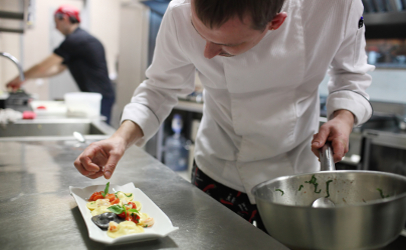Floors in a Food Prep Area Must Be Servsafe
ServSafe Test Question Answers Flow of Food 7th Edition for Safe Food Handler and Food Manager certification exam. Follow manufacturer and local regulatory authority requirements when installing equipment.

Food Safety Experts Can Help Design Kitchens To Reduce Risks Food Safety News
Never let the temperature of the food go above 41F 5C for longer than four hours.

. Minimum Lighting Intensity Requirements. FDA Food Code adoptions by States. ServSafe test prep is based on Chapter 4- Flow of Food.
Glasses and cups should be stored upside down and utensils stored handle up. 15 centimeters off the floor. This will help both the ServSafe Food Protection Manager test and ServSafe Food Handler certificate course preparation.
When purchasing a dishwasher a manager can tell if it is in compliance with the regulatory authority by. Store ready-to-eat food separately from raw food. BOn the floor between uses.
Always use a clean and sanitized food-prep sink when thawing food this way. Registration Information The cost of the 8-hour course is 75 per person and does not include the cost of the ServSafe Manager 7th edition book. Make sure workstations cutting boards equipment and utensils.
Instructor Notes Ask students to identify the situations that can cause cross-contamination. 5Allow the surface to air-dry. Enlarge All flooring in a food prep area of a restaurant must be easy to keep clean in order to prevent mold and bacteria from forming there.
That could make you or your guests sick. CMetal shavings in a can of peaches. Point out that chewing gum in a prep area can spread pathogens to food.
Floor-mounted equipment must be either six inches off the floor or sealed to a masonry base. The curved sealed edge placed between the floor and the wall that makes this area easier to clean is known as. Place in a separate area away from food and food-prep areas The storage area should have.
Explain that cups must be stored upside down on a clean and sanitized surface. Physical and chemical contaminants and methods of prevention. ServSafe Food Handler Course Presentation.
Leave room for air to flow. Stationary equipment must be easy to clean around and under and legs must be at least 6 inches off the floor. This class is designed for anyone working in the food-service industry including non-profit organizations.
COn the work surface of prep tables. Which method is the correct way to dry tableware equipment and food contact surfaces. Provide customers with directions for handling leftovers.
To stay safe follow these guidelines. 2Which is a chemical contaminant. Any surface that touches food such as knives stockpots cutting boards and prep tables must be cleaned and sanitized.
Looking for an NFS seal of approval or a certification from. Foodservice equipment must meet these standards if it will come in contact with food. Equipment and utensils used for food prep must be stored at least six inches from the floor.
Garbage containers stored away from food-prep storage and serving areas. Adoption of the Food Code represents a successful federalstatelocal partnership in improving food safety. ServSafe and the ServSafe logo are registered trademarks of the National Restaurant Association Educational Foundation and used under license by National Restaurant Association Solutions LLC a wholly owned subsidiary of the National Restaurant Association.
ABones in a chicken filet. Use insulated containers to hold TCS food. Minimum Lighting Intensity Area 50 foot-candles 540 lux Prep.
O All food must be date marked is held for longer than 24 hours o RTE food can be stored for only 7 days if held at 41F or lower o When combining food the date to discard will always be the earliest of the foods o FIFO First In First Out o Storage o Food must be 6 off the ground o Do not over pack coolers. Preventing Cross-Contamination When Prepping Food When you prep food you may handle both raw and ready-to-eat food items. Tabletop equipment should be four inches off the floor or sealed to the countertop.
Shelves and storage surfaces must be cleaned and sanitized. AAway from prep areas. Floors in a food prep area must essentially be non-slip so that they prevent spills and accidents.
DWith food supplies below prep tables. Scrape or remove food bits from the surface. Participants must receive a 75 score on the exam to earn a certificate.
To clean and sanitize a surface follow these steps. Tabletop equipment must be either 4 inches off the counter or sealed to the counter. Pathogens can be transferred from one food to another if you are not careful.
When thawing food under running water the flow of the water must be strong enough to wash loose food bits into the drain. Nonabsorbent smooth and corrosion resistant. A food handler prepared a chicken salad on April 10If maintained at 41F or less this food item must be consumed sold or discarded by April 16th During on-the-job training a manager discovers that a food handler is handling raw and then cooked poultry without changing gloves.
Utility sink for filling buckets and washing cleaning tools Floor drain for dumping dirty water Hooks for hanging cleaning tools 11-16 Cleaning and Sanitizing in the Operation. Caterers must follow the same food safety rules as permanent operations.

Server Tip Hands Off Server Food Safety Posters Tips

Fifo Product Rotation Food Safety And Sanitation Food Safety Training Food Safety Posters
0 Response to "Floors in a Food Prep Area Must Be Servsafe"
Post a Comment